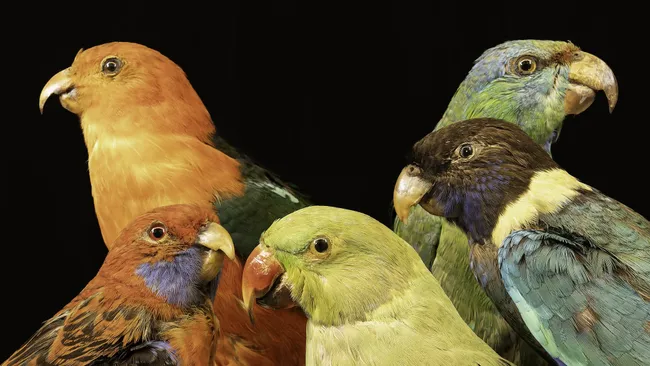Many animals in the tropics are colorful for a number of reasons, including some you might not expect.
From the striking rainbow colors of parrots in the lush rainforests to the brilliant flashes of yellows, oranges, and blues darting across coral reefs, vibrantly colorful wildlife abounds in tropical ecosystems. These dazzling displays of color are some of nature’s most captivating sights, but what is it about tropical environments that has driven so many of their animal inhabitants to evolve such eye-catching hues?
Broadly speaking, animals tend to use color primarily as a means of communication, explained Oscar Puebla, a fish ecologist at the Leibniz Centre for Tropical Marine Research in Germany. “It could be communication with members of your species — for example, to attract a mate,” he said in an interview with Live Science. “It could be communication to predators to make the point that you’re venomous or dangerous. Or it could be camouflage to escape predators.” This variety of functions means that color serves many evolutionary purposes depending on the species and their environment.
The methods animals use to display and produce color vary widely across the animal kingdom. Birds, for instance, often acquire bright pigments such as red, orange, and yellow carotenoids through their diet. These pigments are then deposited in their feathers, creating the vibrant plumage that plays a crucial role in attracting mates or establishing dominance within social hierarchies. Parrots and hummingbirds are classic examples, flaunting radiant hues to stand out in the dense greenery of tropical forests.
In contrast, many fish and mollusks don’t rely solely on pigments but use complex microscopic structures within their cells to manipulate light. These structures bend, scatter, and diffract light in ways that create shimmering, iridescent colors or even allow them to change color dynamically for camouflage. In the clear waters of tropical coral reefs, where predators abound, this ability to blend into the colorful environment or break up their body outline is a powerful survival tool.
The tropical environment itself plays a critical role in the evolution of these colors. Roberto Arbore, an evolutionary biologist specializing in parrots at the Research Center in Biodiversity and Genetic Resources in Portugal, noted that there is a strong correlation between the diversity of a community and the diversity of colors that species display. “If you live in a very diverse community, such as a rainforest, you need to recognize individuals of the same species because interacting with individuals of different species can be very costly,” he explained, referring especially to mating errors or territorial disputes.
This ecological complexity, especially in bird populations, drives an intense competition to stand out visually, which in turn fosters the incredible variety of color patterns found in tropical birds like toucans, hummingbirds, and, of course, parrots. These animals rely heavily on their keen sense of sight to navigate the visual complexity of the forest and communicate with each other, which further pushes the evolution of striking coloration.
However, Puebla cautions that humans must be careful when interpreting these colors and patterns. “The way we perceive colors could be very different from the way other animals perceive it,” he said. This is particularly important in marine environments where light behaves very differently than on land. For example, red light is absorbed very quickly by water, which means that red coloration in deep or clear waters can actually serve as effective camouflage—counterintuitive to how humans see it.
In coral reefs, bright patterns that may seem ostentatious to humans actually help many small fish hide from predators. “Reef fishes have a lot of blue and yellow, but many fish do not see that,” Puebla explained. “These colors have a very strong contrast, so fish use them to break their silhouette as a way of camouflaging.” This is a sophisticated form of visual deception that exploits the specific way colors are perceived underwater.
Apart from the evolutionary pressures and communication needs, there is also a physiological explanation for why so many tropical animals are so colorful. Producing color—whether through pigments or structural features—requires a significant investment of energy. In harsher environments like deserts or tundras, where food and energy are scarce, animals cannot afford to spend as much energy on coloration.
“Tropical habitats are normally richer,” Arbore said. “The conditions are more generous in terms of energy availability, food resources, and milder climate, which strongly impacts the physiology of animals in these environments. Different species can actually invest more energy in producing color because the physiological cost is reduced due to this abundance.” In other words, the environment provides both the incentive and the means for animals to evolve and maintain vibrant coloration.
Whatever the specific evolutionary advantages—whether it be mate attraction, predator deterrence, camouflage, or social signaling—an animal’s color is deeply intertwined with its environment. From the dazzling birds of the rainforest canopy to the brilliantly hued fish of coral reefs and even the more muted tones of deep-sea creatures, color evolution reflects the complex interplay between biology, ecology, and environmental factors.
In tropical ecosystems, the perfect blend of rich resources, high biodiversity, and complex visual environments creates a fertile ground for an explosion of vibrant color, making these habitats some of the most spectacular and colorful on Earth.
